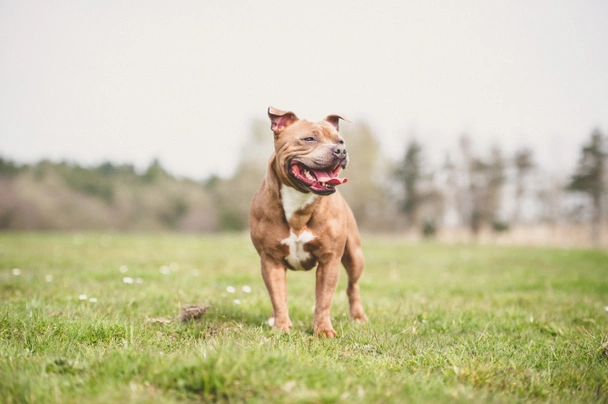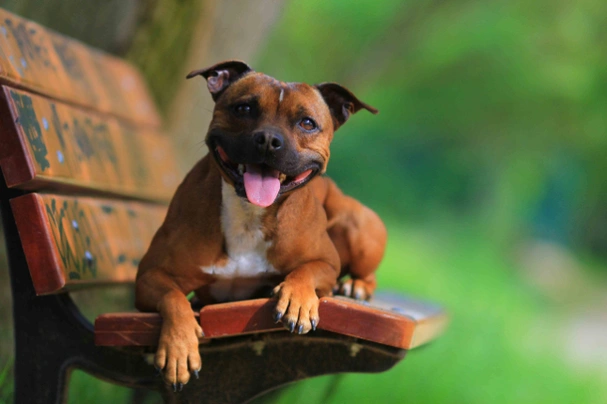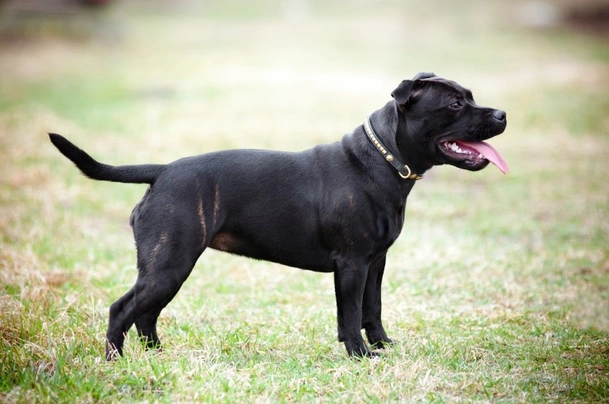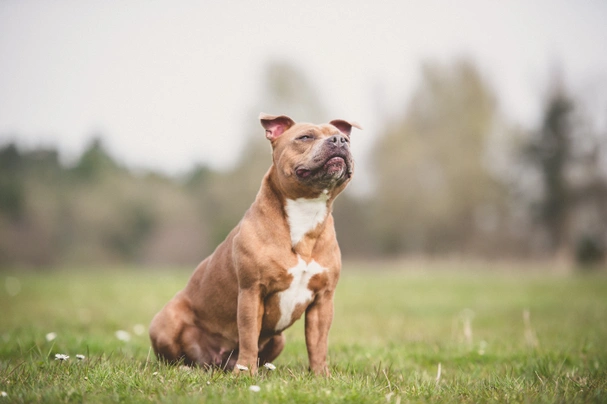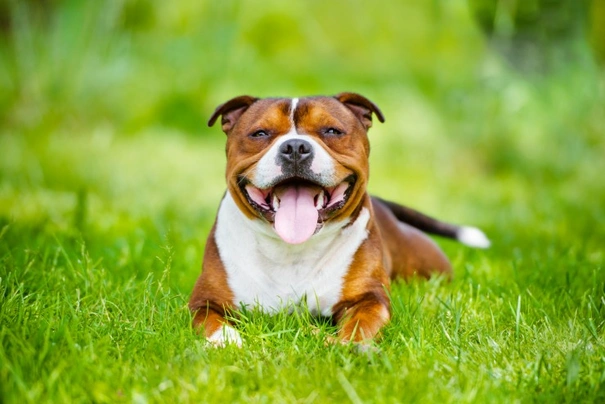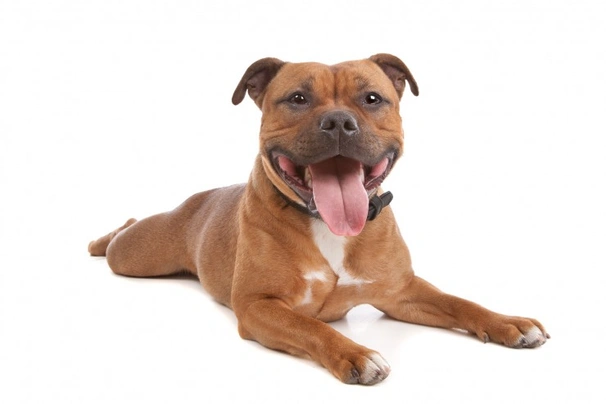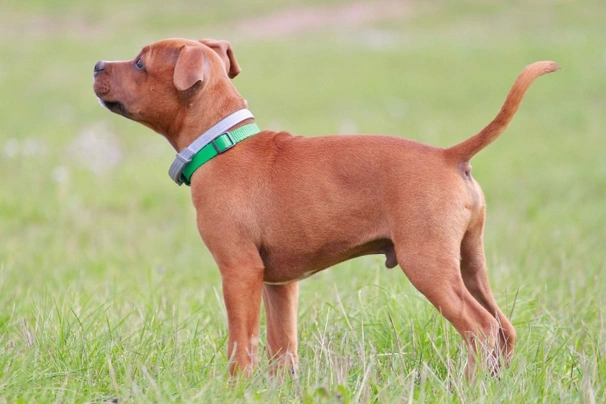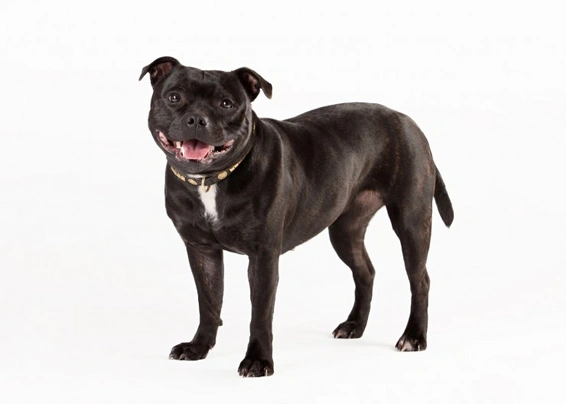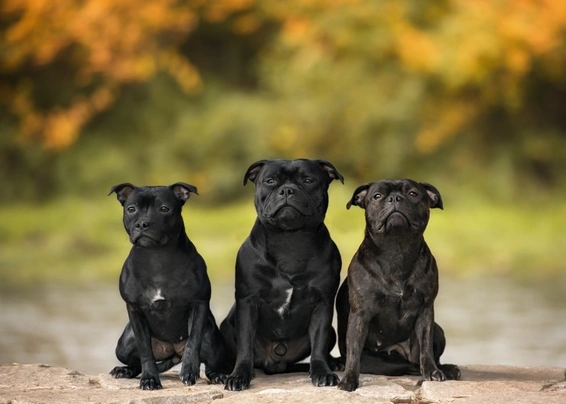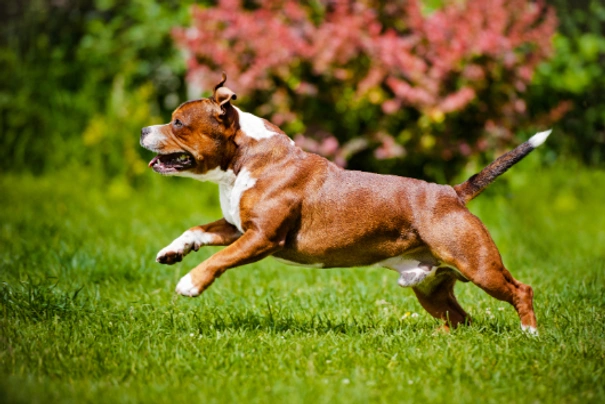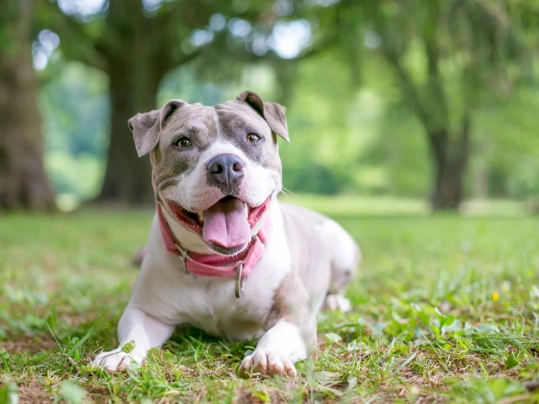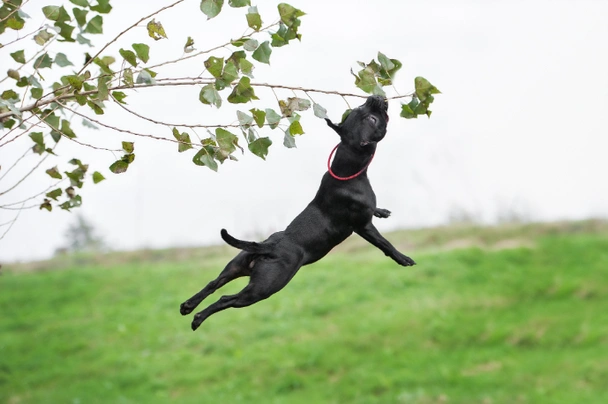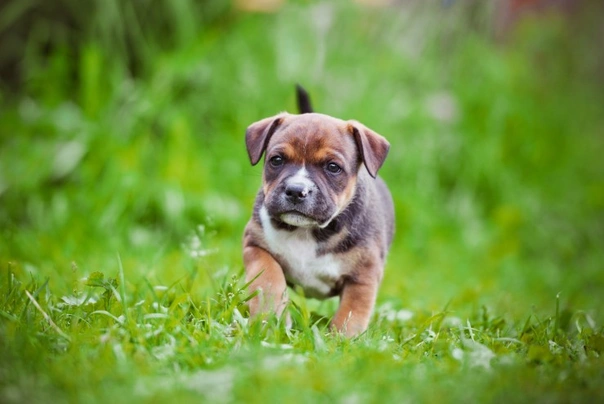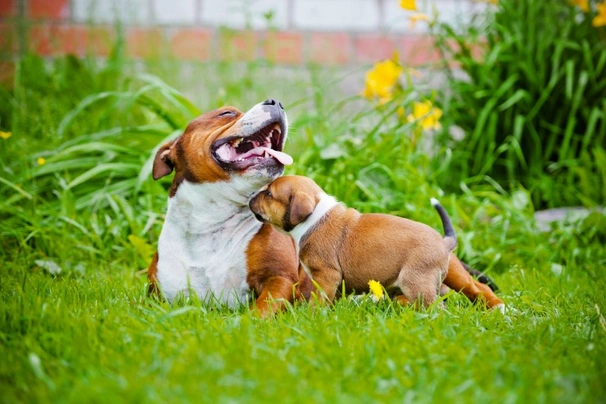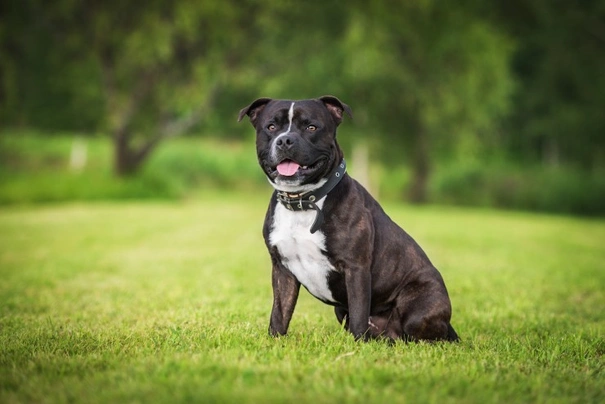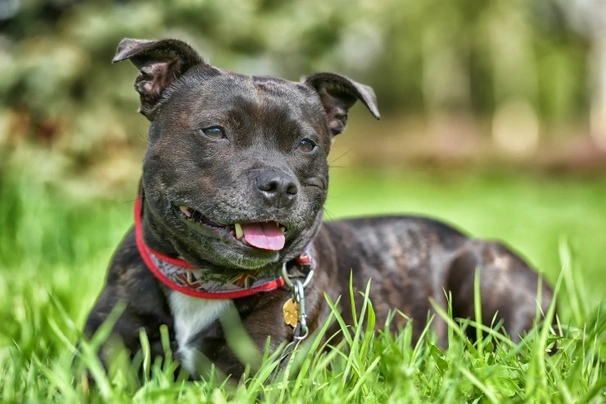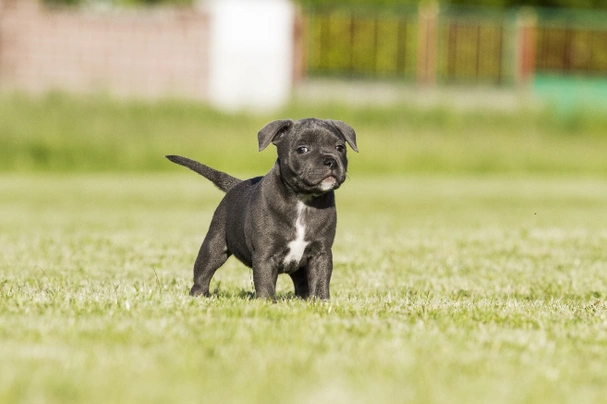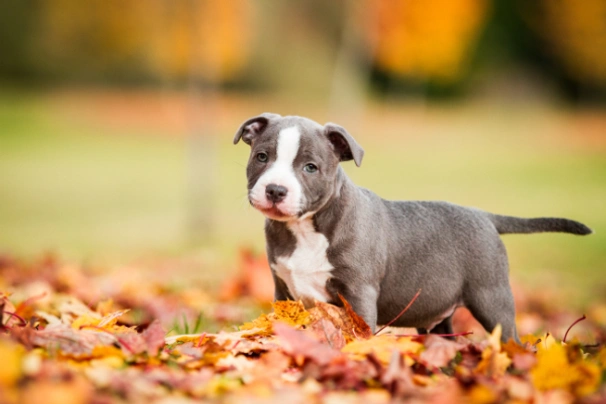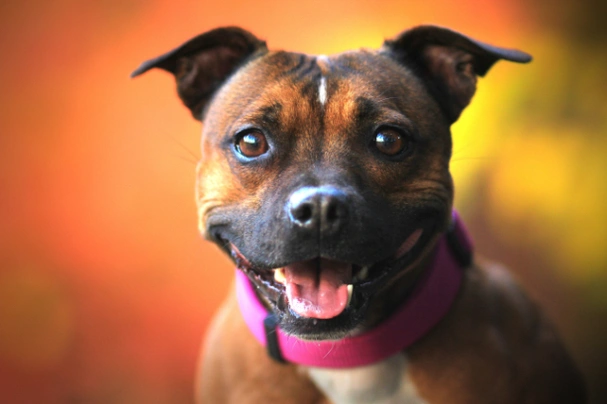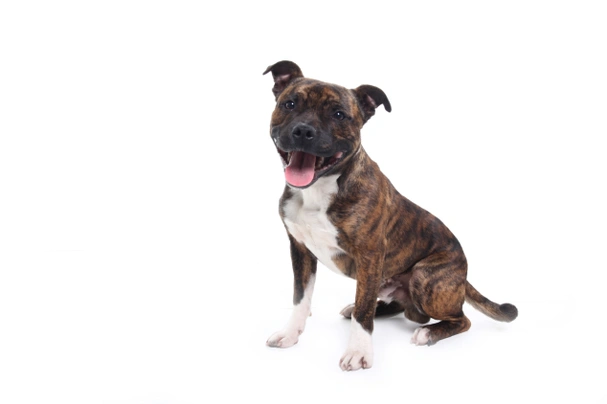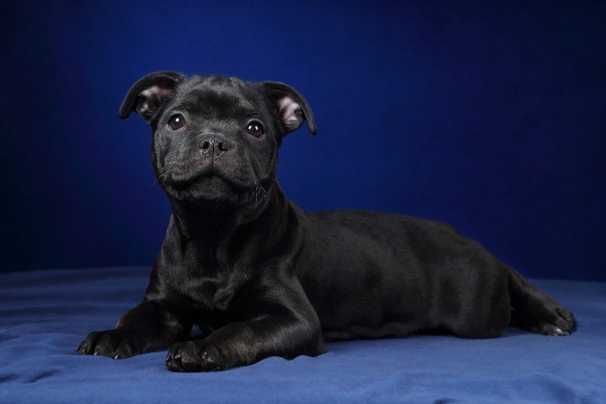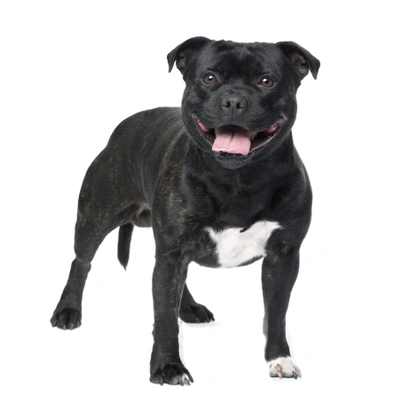Staffordshire Bull Terrier
Pros
Cons
Introduction of the Staffordshire Bull Terrier
Staffordshire Bull Terriers have consistently been one of the most popular choices of terriers and for good reason. They are renowned for the kind natures when they are around people in a family environment even though they were originally bred to be fighting dogs. Staffies have also become one of the most popular dogs in the show ring and luckily this has not affected their traditional strong rugged muscular and much-loved looks. As a tribute to their ancestry Staffies are shown wearing broad leather collars with brass emblems on them which depict Staffordshire knots.
Staffies are fun to have around and although boisterous by nature through correct breeding handling and training these small to medium sized dogs develop into lovely characters that boast big personalities. Staffies like nothing more than a warm lap to curl up on and an owner they can look up to for all the direction and guidance they need with loyalty and devotion. Despite the breed's early origins Staffordshire Bull Terriers is renowned for being a lovely and loyal family pet as well as a trustworthy companion.
History of the Staffordshire Bull Terrier
Staffordshire Bull Terriers share a common ancestry with Bull Terriers and as such they have a similar build. It is generally accepted that Staffies came about by crossing the Bulldog with the Black and Tan terrier with the end goal being to create a strong and courageous fighting and bull baiting dog at a time when both blood sports were extremely popular during the 19th Century. The founder of the breed was a man named James Hinks who continued to develop the breed by introducing Collies into the mix. The result was a different looking dog with quite a unique shape to their heads.
The breed remained popular right up to when blood sports were outlawed across the country although clandestine events were still held in the poorer areas of cities and towns. Dogs of this type grew in popularity although many of them did not survive in the ring or were cast aside for having lost a contest.
Because Staffies were originally bred as fighting dogs gaining recognition from the Kennel Club proved challenging and it was only in the 1930's that the Kennel Club officially recognised the Staffordshire Bull Terrier as a breed in its own right after Staffy enthusiasts established an acceptable breed standard which was a small dog with a malleable personality and one that boasted a real eagerness to please. Today the Staffordshire Bull Terrier remains one of the most popular family pets and companions not only in the UK but elsewhere in the world too.
Interesting facts about the breed
- Are Staffordshire Bull Terriers a vulnerable breed? No they are among the most popular companions and family pets in the UK
- They were originally bred as fighting dogs
- Staffies have Collie in their ancestry
- Some Staffies can show aggression to other dogs
- Staffies have very large jaws and need strong good quality chews to gnaw on
- They have extremely strong personalities and need to know who is boss
Appearance of the Staffordshire Bull Terrier
Height at the withers: Males 36 - 41 cm Females 33 - 38 cm
Average Weight: Males 13 - 17 kg Females 11 - 15.4 kg
Staffies are small to medium sized dogs that boast a compact stocky and muscular appearance which gives them their tenacious look. They boast a broad skull with pronounced cheeks and short foreface with a very distinct stop that's unique to the breed. They have black noses and dark coloured eyes although some dogs with lighter coats may have lighter coloured eyes which is totally acceptable as a breed standard.
Eyes are nicely rounded and medium in size with dark rims which are set in a dog's head which means they look nicely to the front. A Staffie's ears can be half pricked or upright and nicely proportioned in relation to their head. They have ultra-strong jaws with a perfect scissor bite and very strong muscular short necks that go down to broad and powerful shoulders.
A Staffordshire Bull Terrier boasts strong forequarters with well boned legs that are set wide apart. Their feet turn ever so slightly outwards and their shoulders are powerful and well laid back. Their body is nicely proportioned and well defined with a deep brisket and strong rib cage.
Their hindquarters are extremely muscular and built to provide dogs with a lot of power when needed. Their feet are very well padded and medium in size being very strong and nails are always black. Staffies have medium length straight tails that they carry quite low in relation to their bodies.
Their coat is short smooth and close lying with acceptable colours being as follows:
- Red
- Fawn
- White
- Black
- Blue
- All the above colours intermixed with white
- Any shade of brindle
- Any shade of brindle with white markings
The only colours that are highly undesirable in the breed under KC standards are liver and black & tan and any Staffordshire Bull Terrier with these coat colours could not be registered with the Kennel Club.
Gait/movement
Staffies have a powerful action that's free moving and agile. They appear to cover a lot of ground with the minimum of effort. When seen from the front or back their legs move parallel to each other with lots of power coming from their back legs.
Faults
Male Staffies must have two normal testicles fully descended into their scrotums and if they are not this is considered a fault.
The sizes given in their KC breed standard are a guide only as to how tall and how heavy a Staffordshire Bull Terrier should be. As such some dogs can be shorter or taller and they can be lighter or heavier than stated in their KC breed standard.
Temperament of the Staffordshire Bull Terrier
Staffies are known for their bold and courageous natures but the breed is also renowned for being totally reliable and intelligent although they can be headstrong and stubborn. However Staffies need to be handled and trained. When been given the right sort of direction and because they are such smart dogs. they are quick to learn new things. The downside being they are just as fast to pick up bad behaviours as they are the good. With this said a well-bred and well socialised Staffy is a real pleasure to be around. Their reputation for being aggressive by nature is totally unfounded and they should not be thought of as being a "dangerous" breed.
Being intelligent dogs Staffies are easy to train and this includes house training puppies. They just love being around people and don't do well when left on their own for any length of time which could lead to destructive behaviours around the home. Staffies just cannot help themselves when it comes to showing their affection and will jump up so they can lick your face something that even the best trained Staffie cannot resist doing because it's just part of their loving personalities.
The "bad" press the breed has been given over recent years is not merited or well-founded because Staffordshire Bull Terriers when well trained and cared for make for wonderful well-behaved and affectionate family pets that boast endless amounts of energy and enthusiasm for life. They are a real pleasure to have around and share a home with.
Staffies need to be well socialised from a young age for them to accept being around other family pets and any introductions to new animals must be done gently carefully and slowly to avoid any aggressive behaviour. In general when well handled the Staffy shows a gentle and exceptionally loyal nature especially to one person which is typically the person who feeds them. They will also learn to obey commands relatively quickly but be warned - they can have a stubborn streak and can choose to ignore you when the mood takes them. They are also powerful chewers and will resort to chewing anything they can find around the home if left alone for long periods of time. This is simply because Staffies quickly become bored or stressed when left to their own devices. They also need to chew on things to keep their teeth healthy and in good condition. Chewing also helps older Staffies stay relaxed when they are feeling any stress.
Are they a good choice for first time owners?
Staffies are a good choice for first time owners because they are so people-oriented. However they thrive on human company and hate being left on their own which in short means they are better suited to households where at least one person stays at home when everyone else is out. They also need to know who is the alpha dog in a household because without the right sort of direction and guidance a Staffy might take on that role which can make them harder to manage.
What about prey drive?
A lot of Staffies have extremely strong prey drives and should not be allowed to run free in areas where they might come across smaller animals and dogs they don’t already know.
What about playfulness?
Although impressive in appearance a well socialised Staffy likes to play and they can play hard. They are not the sort of dog that will happily walk along taking things slowly when they could show a burst of speed and play and interactive game at full pelt.
What about adaptability?
Staffies are highly adaptable being just as happy living in an apartment in town as they would be living in a house in the country providing they are given plenty of mental stimulation daily exercise and not left on their own for any length of time which could result in a dog being destructive around the home.
What about separation anxiety?
Because Staffies are so people-oriented they hate it when they find themselves on their own and therefore they can suffer quite badly from separation anxiety. This often sees a Staffy being destructive and with such powerful jaws the damage a dog can do to furniture as a way of showing their stress is quite considerable.
What about excessive barking?
Staffies are not known to be "barkers" but will be quick off the mark to let an owner know when there are strangers about or when something they don't like is going on in their environment.
Do Staffies like water?
No most Staffies do not like being in water and are not particularly good swimmers which is why care should always be taken when they are around any water courses which includes ponds rivers lakes and the sea.
Are Staffies good watchdogs?
When correctly socialised from a young age Staffies make very good watchdogs because they go about their duties in a very sensible way.
Intelligence / Trainability of the Staffordshire Bull Terrier
Staffies are intelligent and when they are responsibly bred are known to be stable and confident dogs. In the right hands with the correct amount of training they are quite easy to train providing their owners can match their pet's intelligence because a Staffy will always test the limits as to how far they can go. Staffies are known to have a stubborn streak in them which means they need to be handled with a firm yet gentle hand. Getting a dog to focus can be problematic especially when Staffies are still young because they can be boisterous and quite headstrong as puppies and in their "teenager" years. With this said once you've got their attention they will listen and learn but it's essential for Staffordshire Bull Terriers to be well socialised from a young age for them to be more manageable adult dogs.
Their training must start early before they pick up any bad habits which could prove challenging to correct further down the line. Teaching a Staffy the basic commands from the word go is essential and does pay dividends as a dog matures always bearing in mind that Staffordshire Bull Terriers are known to be quite independent and headstrong by nature. The commands a Staffy puppy should be taught right from the start are as follows:
- Sit
- Stay
- Leave it
- Come
- Wait
- Quiet
- Bed
Children and other
The Staffordshire Bull Terrier is known to be kind and tolerant towards children of all ages although because they are also known to play roughly and can be boisterous at times Pets4homes advises that Staffies are not the best choice for families with babies or very young children. Anyone who already shares a home with a Staffy and who has younger children should always make sure the children and their dog are never left together unattended. It is also crucial for parents to teach young children how to behave around dogs and when to stay away from them particularly when there is food around or during playtime.
Staffies need to be well-socialised when they are still puppies and introduced to as many other animals and situations as possible for them to be well-rounded mature dogs. However they can show aggression towards other dogs and pets which is why it's important they be introduced to each other slowly and carefully to make sure things go smoothly and that no pets get stressed out which could lead to aggressive behaviour.
A Staffy's breeding plays a huge role in their temperaments and how a dog reacts not only to other dogs but to other animals and pets. In short it's essential that potential owners make sure a puppy they are interested in owning has been well-bred nicely socialised and that their parents have stable and kind personalities too.
Health of the Staffordshire Bull Terrier
The average life expectancy of a Staffordshire Bull Terrier is between 12 - 14 years when properly cared for and fed an appropriate good quality diet to suit their ages.
Although a healthy breed the Staffy is known to suffer from a few hereditary and acquired health issues which are worth knowing about if you have decided to share a home with one of these delightful and affectionate dogs. The most commonly seen health disorders are as follows:
- Hereditary cataracts (HC) - tests are available and stud dogs should be tested before being used for breeding purposes
- L-2- hydroxyglutaric aciduria (L2HGA) - a metabolic health issue - DNA test available and stud dogs should be tested before being used for breeding purposes
- Distichiasis
- Persistent Hyperplastic Primary Vitreous (PHPV) - tests available which should be done throughout a dog's life
- Posterior polar subcapsular cataract - PPSC - stud dogs should be tested annually
- Mastocytoma (mast cell tumours)
More about L2-HGA
A few Staffies have been reported as suffering from this metabolic disorder which sees dogs display varying degrees of behavioural changes as well as dementia. Dogs suffer anxiety attacks and can experience full blow seizures. They are exercise intolerant and suffer from an unsteady gait (ataxia). They experience tremors and stiffness in their muscles. It is known to have an autosomal recessive mode of inheritance and as such both parents must carry the defective gene in order to pass the condition on to their offspring.
All Staffordshire Bull Terriers destined to be used in a breeding programme must be screened prior to being used which can be done by sending a blood sample to the AHT in Newmarket. It is worth noting that results from blood samples usually take up to 6 weeks to be sent out and as such not dogs should be mated until their results are known.
More about hereditary cataracts
Hereditary cataracts are an inherited condition and again it is an autosomal recessive disorder so both parent dogs must carry the defective gene to pass it on to their offspring. A puppy may be born with perfectly healthy eyes but this changes as time passes. The cataracts typically start developing when affected puppies are around 8 months or so old. The condition affects both eyes and because it is progressive dogs suffering from the condition will eventually lose their sight. All Staffies should be DNA tested more especially dogs used in a breeding programme. Blood samples are sent to the AHT in Newmarket and results can take anything up to 6 weeks to complete.
More about persistent hyperplastic primary vitreous
Persistent hyperplastic primary vitreous has been reported in the breed and although the exact reason why some Staffies develop the condition it is known to be a congenital disorder that is non-progressive. In short Staff puppies are born with the condition but it does not get any worse. Puppies can be screened when they are 6 weeks old and if the disorder is deemed necessary it can be surgically corrected although the procedure is invasive and expensive to carry out. There is a genetic test available and it's essential for all breeding stock to be tested before being used in a breeding programme.
More about posterior polar subcapsular cataracts
Staffies can suffer from PPSC which is a condition seen in other breeds notably the Golden and Labrador Retriever. The disorder does not typically affect a dog's vision and there is a BVA/KC/ISDS Eye Scheme available but it is worth noting that the disorder cannot be detected by screening litters. All stud dogs must be tested every year to establish they are clear of the disorder before being used for breeding purposes.
What about vaccinations?
Staffy puppies would have had their first vaccination prior to being sold. After this they need to be vaccinated again following the guidelines below:
- 10 -12 weeks old bearing in mind that a puppy would not have full protection straight away but would be fully protected 2 weeks after they have had their second vaccination
When it comes to boosters it's best to discuss these with a vet because there is a lot of debate about whether a dog really needs them after a certain time. However if even a dog needs to go into kennels their vaccinations would need to be fully up to date.
What about spaying and neutering?
Female Staffies can be spayed when they are 6 months old and not beforehand. Males can be safely neutered when they are 6 months old too providing their testicles have fully dropped into their scrotums.
What about obesity problems?
Staffies are not known to be fussy eaters and some of them like their food a little too much. The problems can start when a dog is spayed or neutered and is when they could be prone to gaining weight. It's very important to keep an eye on a Staffy's weight and to ensure a dog is not being overfed or not given enough daily exercise bearing in mind that being obese will shorter a dog's life by several years and put them at risk of developing a lot more health issues.
What about allergies?
Some Staffies may be prone to allergies whcih can be caused by various things and all too often finding the triggers proves challenging. With Staffies the most common causes are as follows:
- Diet
- House and dust mites
- Environment
- Grasses and pollens
- Wheat and other cereals
Recognising health issues in Staffordshire Bull Terriers
Recognising when a Staffy could be developing a health issue and having them examined sooner rather than later often means their condition can be easier to treat. It does also mean that a dog is made to feel more comfortable as quickly as possible.
Participating in health schemes
All Staffies destined to be used in a breeding programme must be screened and DNA tested for specific health concerns which are as follows:
- Hereditary Cataract (HC-HSF4)
- L-2- hydroxyglutaric aciduria (L2-HGA)
- Persistent Hyperplastic Primary Vitreous (PHPV)
- Posterior polar subcapsular cataract - (PPSC)
What about breeding restrictions?
The Kennel Club observes strict breeding restrictions which can be found on their site and which all potential buyers should be aware of. This includes the number of litters a dam has produced and her age.
What about breed specific breeding restrictions?
Merle Staffordshire Bull Terrier puppies can no longer be Kennel Club registered because they are at greater risk of having both impaired vision and hearing due to the merle gene they carry. Any Staffies with the merle gene should not be used for breeding purposes.
What about Assured Breeder Requirements?
It is mandatory for Kennel Club Assured Breeders to have their stud dogs tested for the following:
Another test that the Kennel Club recommends all breeders carry out on their stud dogs but which is not mandatory is as follows:
Caring for the Staffordshire Bull Terrier
As with any other breed Staffies need to be groomed on a regular basis to make sure their coats and skin are kept in tip-top condition. They also need to be given regular daily exercise so they remain fit and healthy. On top of this Staffordshire Bull Terriers need to be fed a good quality diet throughout their lives to ensure all their nutritional needs are met.
Caring for a Staffy puppy
Staffy puppies are incredibly cute and well socialised puppies adapt well and quite quickly to a new environment providing they are not left on their own that is. Reputable breeders will only let their puppies go to their new homes when they are 8 to 12 weeks old and never earlier or when they are younger than this. The longer a puppy can stay with their families the better it is for them.
A puppy should have already been given the first of a series of vaccinations and have been microchipped. They would also have been wormed and all this information should be included in their paperwork. The documentation should include any health concerns the breed is known to suffer from and the puppy's KC registration information.
Puppies are sent to their new homes with a feeding schedule detailing what they have been fed and the frequency of their meals which is typically four times a day once a puppy has been weaned off their mother. Staffy puppies need lots of sleep which can be anything up to 21 hours in a 24-hour period. Because Staffy puppies are so cute it is all too easy to spoil them which is often the case. This can lead to all sorts of problems later on with adult dogs showing a more dominant and wilful side to their natures a condition known as small dog syndrome. It's essential to lay down some ground rules right from the word go to avoid this from happening.
Puppies need to be taught limits and boundaries although some Staffies will always test how far they can go. All dogs whether young or old like to know what is expected of them and who they can look to for direction and guidance. Even small dogs must know who is the apha dog in a household to prevent unwanted behaviours.
A new puppy should never be left on their own so it's crucial to time their arrival when there will be people around for the first few days. It takes puppies a while to get used to a strange environment and they need housetraining which must start as soon as they arrive. In short it's a good idea to take a few days off work to spend with a new puppy as a way of settling them that much faster without the stress of finding they are suddenly all alone.
It's also important to make a note of the next time a puppy needs to be wormed and as a guide this should be calculated from the date they were last wormed by the breeder:
- Puppies should be wormed at 6 months old
- They need to be wormed again when they are 8 months old
- Puppies should be wormed when they are 10 months old
- They need to be wormed when they are 12 months old
Setting up a area for a puppy in a quiet part of the house is important because they need to nap throughout the day and the more peaceful an area is the better they would be able to relax and unwind. As previously mentioned puppies often sleep for 21 hours a day in between bouts of play. Placing a bed or crate somewhere that's quiet but not too out of the way will help them settle when they need to sleep. However it needs to be somewhere that owners can keep an eye and ear on them and so puppy knows there is someone around.
Things you'll need for your puppy
Getting everything ready for the arrival of a new puppy means making the home and garden safe for them. Puppy proofing takes organising things around the house but is something that needs to be done well in advance of a puppy's arrival because puppies are boisterous inquisitive and notorious for chewing on things they shouldn't which includes electric cables and other things they can swallow which could end up with an expensive trip to the vet.
Some owners buy playpens which are great for keeping puppies safe when they want to play and owners are too busy to keep a close eye on their pets. Other things needed for puppies include the following:
- Child gates to fit on doors to prevent a puppy from getting in or out of a room
- Shallow water and food bowls that are ceramic dishes rather than metal or plastic
- Good quality toys and chews for puppy to gnaw on bearing in mind that this is something that most puppies do and that they will start their teething process when they are anything from 3 to 8 months old.
- A slicker brush or soft bristle brush
- Dog specific toothpaste and a toothbrush
- Scissors with rounded ends
- Dog shampoo and conditioner never use baby or people shampoo on a Staffy puppy which could end up triggering a nasty skin allergy
- A well-made dog harness and/or extra wide puppy collar
- A strong lead
- A well-made dog bed that's not too small or too big and one that puppy would not chew and destroy
- A good-sized dog crate that's not too small or too big
- Baby blankets which are ideal for putting in a puppy's bed for them to sleep on
- A grooming mat
Feeding guide for a Staffy puppy
Staff puppies need to be fed a good quality diet that provides them with all the vitamins minerals and other nutrients they need to grow and develop properly. Ideally puppies need to be at least 3 to 4 times day until they are around 11 months old. If you are just about to get a puppy from a breeder they would recommend you feed them the same diet as they have been on and to gradually change this over a period of a few weeks to avoid the puppy developing a tummy upset.
Reputable Staffordshire Bull Terrier breeders would always make sure they give potential owners a contract which would include all a puppy's paperwork. The schedule should cover the following:
- A feeding schedule for the puppy stating what type of food they have been eating and how many times they are fed every day.
It is very important to stick the schedule for the first week or so but a puppy's diet can be changed once they are settled into their new homes providing it is done gradually and carefully over a period of 4 weeks making sure that puppy does not experience any digestive upset and if they do to change back to their original diet before discussing things with the breeder or the vet.
It's important to set up a routine as soon as a new Staffy puppy arrives in the home because this helps with their settling in period. They need to be fed at the same times of the day and ideally this needs to be 4 times a day until a puppy is around 6 months old after which time they can be fed 3 times a day till they are 11 months old. Below is a rough feeding guide of how much a Staffy puppy should be fed daily during the first months of their lives:
- 2 months old - 80 g to 115 g depending on a puppy's build
- 3 months old - 90 g to 135 g depending on a puppy's build
- 4 months old - 94 g to 143 g depending on a puppy's build
- 5 months old - 94 g to 145 g depending on a puppy's build
- 6 months old - 86 g to 144 g depending on a puppy's build
- 7 months old - 77 g to 91 g depending on a puppy's build
- 8 months old - 68 g to 116 g depending on a puppy's build
- 9 months old - 67 g to 103 g depending on a puppy's build
- 10 months old - 67 g to 102 g depending on a puppy's build
Keeping the noise down
Like all other puppies Staffies can sleep or up to 21 hours in any 24-hour period which they need to do so they build up their strength for the next bout of playtime and so they continue to grow properly. It's important to keep noise levels down because they are sensitive to loud sounds and this includes noise from a television or any other device.
Keeping vet appointments
A puppy needs to have all their vaccinations at specific times so they are fully protected. It's essential to keep vet appointments not only for a puppy to be given their remaining jabs but so a vet can check them over too.
What about Staffies when they reach their golden years?
Staffies like other breeds slow down as they age which often means they are slower to respond to when they are called or maybe their hearing and eyesight are not as good as they once were which all needs to be factored into their management and care. Older dogs can be less eager to go out for walks but it's important not to let them become couch potatoes. They need to be given the right amount of mental stimulation which helps maintain their cognitive function through their golden years.
An older Staffy may get a little fussier about their food so it's important to rethink a dog's diet if necessary following the advice of an expert nutritionist or the vet
Grooming of the Staffordshire Bull Terrier
Having a short close-lying coat means the Staffy is low maintenance when it comes to grooming. A weekly brush and wipe over with a chamois leather is all it takes to keep their coats and skin in good condition. The same can be said for bathing them which should only really need doing from time to time. Overbathing a Staffy can destroy all the natural oils found in their skin and coats upsetting the PH balance and this can result in a dog developing skin allergies which some of them are prone to suffering from.
Just like other dogs Staffies shed more hair during the Spring and then again in the Autumn which is when more grooming is needed to keep on top of any loose hair and to prevent a dog from leaving it around the home. Setting up a grooming routine also allows owners to keep an eye on the condition of a dog's skin and to clean their ears when necessary because if there is too much wax in their ear canals it could lead to an infection taking hold and these are notoriously hard to clear up.
Grooming tools needed for Staffies
Investing in good quality grooming tools means they will last a lot longer than any cheaper ones and the tools needed when sharing a home with a Staffy are as follows:
- A good quality bristle brush
- A pin-brush
- A slicker brush
- A pair of round ended scissors
- Chamois leather
- Nail clippers
Exercise of the Staffordshire Bull Terrier
The Staffordshire Bull Terrier is a high-energy dog and needs to be given a minimum of 1 hour's rigorous exercise a day when it comes to exercise or boredom will set in leading to some unwanted and often destructive behaviours. The more exercise a Staffy is given the better and more relaxed a dog would be and the old adage of a "tired dog being a good dog" is never truer than when it comes to describing these energetic little dogs. It is worth bearing in mind that Staffies are real athletes capable of scaling a 6-foot fence with no effort at all. They are also incredibly good at digging their way under fences which is something to bear in mind when leaving a dog in a back garden.
Staffies enjoy as much "off the lead" time as possible so they can really express themselves but they are not the sort of dog that can be let loose in a park or anywhere else where there are lots of dogs just in case they get into a fight.
Because they are such intelligent dogs they also need to be given lots of mental stimulation for them to be truly happy relaxed and well-balanced dogs. After a good amount of physical exercise and playing lots of interactive games a Staffy likes nothing more than to relax on a couch with their owner tired but an extremely happy dog.
Feeding of the Staffordshire Bull Terrier
Mature Staffies should be fed a small breakfast and then another larger meal in the evening but again their diet needs to be high in protein because they are such energetic dogs and as such they need the extra nutrients to meet their daily nutritional needs. The one constant no matter whether you feed a Staffordshire Bull Terrier wet or dry food you must make sure they always have access to fresh clean water at all times.
Feeding guide for an adult Staffordshire Bull Terrier
As previously mentioned a mature Staffy can be fed twice a day and as a rough guide the amounts they can be given are as follows:
- Dogs weighing 4 kg - 67 g to 78 g a day
- Dogs weighing 5 kg - 79 g to 92 g a day
- Dogs weighing 6 kg - 91 g to 105 g a day
- Dogs weighing 7 kg - 102 g to 118 g a day
Staffordshire Bull Terrier price
A well-bred Staffordshire Bull Terrier can cost you anything from £700 to well over £2000 for a pedigree puppy.
The cost of insuring a male 3 year old Staffie in the north of England would be £21 for basic cover up to £47.30 a month for a lifetime policy (quote as of August 2017). It's worth bearing in mind that lots of things are factored into a pet's insurance premium and this includes where you live in the UK and a dog's age.
When it comes to food costs you would need to buy the best quality dog food whether wet or dry for your dog throughout their lives and to suit the different stages of their lives. This would set you back between £30-£40 per month. On top of this you would need to factor in veterinary costs if you want to share your home with a Staffy and this includes their initial vaccinations neutering or spaying a dog when the time is right and then their annual health checks all of which quickly adds up to over a £800 a year.
The total average cost to keep and care for a Staffordshire Bull Terrier as a rough guide would be in the region of £50 - £100 a month depending on the level of pet insurance cover you opt to buy but this does not include the initial cost of buying a pedigree Staffordshire Bull Terrier puppy.
Buying advice
When visiting and buying any puppy or dog there are many important things to consider and questions to ask of the breeder/seller. You can read our generic puppy/dog advice here which includes making sure you see the puppy with its mother and to verify that the dog has been wormed and microchipped.
When buying a Staffy the size of a dog as stated in the Kennel Club Breed Standard is only a guide and is given as being the ideal for the breed. As such a Staffy could be smaller or larger and may weigh slightly more or less than the given size in their breed standard.
Staffies are an extremely popular breed both in the UK and elsewhere in the world which means that well-bred puppies command a lot of money. As such with Staffies there is specific advice questions and protocols to follow when buying a puppy which are as follows:
- As previously touched upon Staffies are among the most popular breeds in the UK. As such there are many amateur breeders/people who breed from a Staffy far too often so they can make a quick profit without caring for the welfare of the puppies their dam or the breed in general. Under Kennel Club rules a dam can only produce 4 litters and she must be between a certain age to do so. Anyone wishing to buy an Staffy puppy should think very carefully about who they purchase their puppy from and should always ask to see the relevant paperwork pertaining to a puppy's lineage their vaccinations and their microchipping

SUPERIOR RED STAFFORDS AVAILABLE CH BLOODLINE
£2,500
9 Beautiful Black & Blue pups
£2,350
